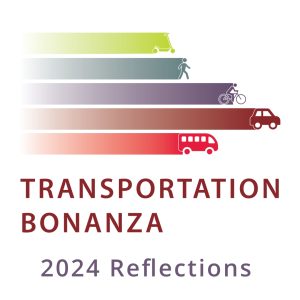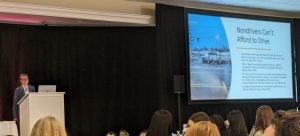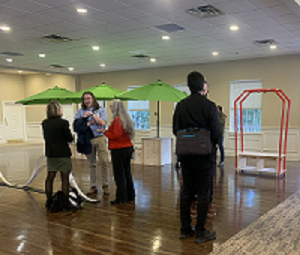 This year’s Transportation Bonanza brought together professionals in transportation, planning, and public health to learn about Safe Routes to School and active transportation. Held in person for the first time since 2020, the full-day conference gave us all the opportunity to gather, collaborate, connect, and reconnect with one another on a deeper level. Our team left the conference inspired by the insights and best practices shared. We look forward to incorporating everything we learned back to the Safe Routes to School program and the important work it does to serve the youngest residents of our state.
This year’s Transportation Bonanza brought together professionals in transportation, planning, and public health to learn about Safe Routes to School and active transportation. Held in person for the first time since 2020, the full-day conference gave us all the opportunity to gather, collaborate, connect, and reconnect with one another on a deeper level. Our team left the conference inspired by the insights and best practices shared. We look forward to incorporating everything we learned back to the Safe Routes to School program and the important work it does to serve the youngest residents of our state.
“True to form, we received a morning snowstorm that made travel challenging for some participants. For those of us who braved the weather, we heard inspiring presentations about projects and programs in Michigan, best practices from around the nation, and had the opportunity to interact with old friends and new colleagues working to make Michigan a better place to live, work, and play.
The event was well attended, and conference attendees brought their energy and enthusiasm. In addition to the keynote speeches and breakout presentations, the day included breakfast, lunch, and intermissions used to continue topic discussions, connect with others, and view quick-build equipment that communities could use to demonstrate proposed active transportation infrastructure treatments.
While virtual conferences have their benefits, it was great to be back in person and have opportunities for impromptu conversations, chance meetings, and face-to-face interactions that foster professional relationships and a dynamic atmosphere. The plan for Transportation Bonanza going forward is to alternate between a live event and a virtual conference each year, so hopefully we can offer the best of both worlds with a little variety.”
~ Max Fulkerson, Director of SRTS
 “One of the resounding messages at Transportation Bonanza 15 was on the importance of safe systems design for priority funding. I appreciate the aspects of the conference that were on how we all innately have flaws and vulnerabilities as humans. Our roadways should be designed with safe systems approaches that account for this characteristic of human error so that when errors happen, they don’t risk costing someone their life.
“One of the resounding messages at Transportation Bonanza 15 was on the importance of safe systems design for priority funding. I appreciate the aspects of the conference that were on how we all innately have flaws and vulnerabilities as humans. Our roadways should be designed with safe systems approaches that account for this characteristic of human error so that when errors happen, they don’t risk costing someone their life.
Our transportation system has long centered cars over people and the resulting traffic violence has been disproportionately a burden on the “silently suffering” members of our community as Veronica Davis highlighted in her keynote presentation. Individuals with low influence and power need to be central in our decision-making processes and funding priorities. She believes that dominant power dynamics have historically allowed content expertise to be held in higher regard than the context expertise of the residents and citizens who are long impacted after the content experts pack up after their engagement meetings or head to the next project when construction is completed. Anna Zivarts‘ keynote similarly emphasized these power dynamics and how improving the quality of life for the most vulnerable and overlooked members of our communities stems from meaningful engagement and mindful attention to how we allocate services and resources.”
~ Colleen Synk, Sr. Operations & Evaluation Coordinator
 “It is very inspiring to hear about the ways the presenters and professionals in the field have applied their passion for active transportation to enact shifts in policy and institutional attitudes for safety. Through methodical and diligent outreach, the Crim Fitness Foundation has advanced its Safe Routes work into the mission of the foundation and is expanding into place-making initiatives like Better Block.
“It is very inspiring to hear about the ways the presenters and professionals in the field have applied their passion for active transportation to enact shifts in policy and institutional attitudes for safety. Through methodical and diligent outreach, the Crim Fitness Foundation has advanced its Safe Routes work into the mission of the foundation and is expanding into place-making initiatives like Better Block.
Dave Cowan’s experience was insightful regarding how to bring temporary demonstrations into school safety planning processes which Minnesota DOT make changes to engineering approachesl. This approach led to a state-wide guidebook being adopted in Minnesota that is now available for communities to enact practical and quick treatments to increase safety while building consensus for permanent infrastructure in the future. “
~Adam Jenks, Sr. Contracts & Data Coordinator
